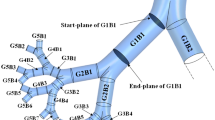Abstract
Assuming that along the pulmonary arteries, mathematical expectations of branching are equal to matrix (E i,j; i: parent branch class, j: daughter branch class number), we made computer drafts of patterns of pulmonary arterial branching trees from the published data of canine pulmonary arterial casts with the “Monte Carlo methods” by FORTRAN, calculating from these data, the numbers of branches, size and resistance of the trees. We also analyzed blood flow distribution in a pulmonary branch according to the pathlength from the entrance of the tree. The graphics of the trees were similar to the original arterial casts, and numbers of the branches were nearly the same as the previous reported values. Calculated resistance was reasonable. The rate of blood flow per unit vessel in the short pathlength group was calculated as 1.5 times that of the long pathlength group of the same diameter. We believe that our method of describing the branching pattern matrix (E i,j) provides a reasonable simulation of complex branching patterns such as pulmonary arteries and a useful means to analyze local hemodynamics.
Similar content being viewed by others
Abbreviations
- i:
-
class number of parent element
- j:
-
class number of daughter element
- k :
-
branching number
- m :
-
daughter element number at one branching
- n :
-
number of pathlength group
- z :
-
generation number
- d z,i :
-
diameter ofzth-generation and i-class element
- len(i):
-
length of i-class element
- N i,j :
-
observed number of j-class from i-class
- Nt:
-
total number of branching
- N el(i):
-
element number of i-class element
- N tr(i):
-
tree number of i-class element
- TNEEt :
-
total number of the exits of the model of tree
- TNEE(n):
-
total number of the exit elements of group-n
- R:
-
resistance
- Rp:
-
peripheral resistance from one exit to left atrium
- Rt:
-
peripheral resistance from one exit to left atrium
- Rt(n):
-
Rt when the Rp ofn-group is infinite
- Rc:
-
the imaginary resistance of the model of tree
- C 1(n):
-
the imaginary conductance of one exit vessel of n-group
- r :
-
random disit
- E i,j :
-
the matrix of mathematical expectation of branching
- a :
-
coefficient of becoming narrow
References
Bergel, D.H., Milnor, W.R. Pulmonary vascular impedance in the dog. Circ. Res. 16:401–415; 1965.
Bhattachrya, J.; Nanjo, S.; Staub, N. Micropuncture measurement of lung microvascular pressure during 5-HT infusion. J. Appl. Physiol. Respirat. Environ. Exercise Physiol. 52:634–637; 1982.
Caro, C.G.; Pedley, T.J.; Seed, W.A. Mechanics of the circulation. In: Guyton, A.C.; Jones, C.E., eds. Cardiovascular physiology MTP international review of science, physiology series one. London: University Park Press; 1974.
Cumming, G.; Henderson, R.; Horsfield, K.; Singhal, S. The functional morphology of pulmonary circulation and interstitial space. Chicago: University of Chicago Press; 1969; pp. 327–340.
Dawson, C.A. Role of pulmonary vasomotion in physiology of the lung. Physiol. Rev. 64:544–616; 1984.
Elliot, F.M.; Reid, L. Some new facts about the pulmonary arteries and its branching patterns. Clin. Radiol. 16:193–198; 1965.
Harris, P.; Heath, D. The structure of the normal pulmonary vessels after infancy. In: The human pulmonary circulation. 2nd ed. London: Churchill Livingstone, Edinvergh; 1977.
Horsfield, K.; Thurlbeck, A. Computer simulation of the geometry of the human bronchial tree. Bull. Math. Biol. 46:389–398; 1984.
Hyland, J.W., Smith, G.T., McGuire, L.B.; Harrison, D.C.; Haynes, F.W.; Dexter, L. Effect of selective embolization of various sized pulmonary arteries in dogs. Am. J. Physiol. 204:619–625; 1963.
Koike, K. Analysis of the branching pattern of pulmonary arteries. Kousankinbyou Kenkyuusho Zasshi 31:54–74; 1979.
Koike, K.; Onuki, T.; Okuda, K.; Nitta, S.; Nakada, T. Branching architecture of canine pulmonary arteries: A quantitative study. Tohoku J. Exp. Med. 149:293–305; 1986.
Lavor, M.B.; Austen, W.G.; Wilson, R.S.. Blood-gas exchange and hemodynamic performance. In: Sabiston, D.C.; Spencer, Jr., F.C., eds. Gibbon's surgery of the chest. 3rd ed. Philadelphia WB Saunders Company; 1976.
Nagasaka, Y.; Bhattachrya, J.; Nanjo S.; Gropper, M.A.; Staub, N. Micropuncture measurement of lung microvascular pressure profile during hypoxia in cats. Circ. Res. 54:90–95; 1984.
Singhal, S.; Henderson, R.; Horsfield, K.; Harding, K.; Cumming, G. Morphometry of the human pulmonary arterial tree. Circ. Res. 33:190–197; 1973.
Strahler, A.N. Quantitative analysis of watershed geomorphology. Tr. Am. Geophys. Union 38:913–920; 1957.
Weibel, E.R. Morphometry of the human lung. Berlin: Springer-Verlag; 1963.
West, J.B.; Dollery, C.T. Distribution of blood flow and pressure-flow relations of the whole lung. J. Appl. Physiol. 20:175–183; 1965.
Zhuang, F.Y.; Fung, Y.C.; Yen, R.T. Analysis of blood flow in cat's lung with detailed anatomical and elasticity data. J. Appl. Physiol. Respirat. Environ. Exercise. Physiol. 55:1341–1348, 1983.
Author information
Authors and Affiliations
Rights and permissions
About this article
Cite this article
Onuki, T., Nitta, S. Computer simulation of geometry and hemodynamics of canine pulmonary arteries. Ann Biomed Eng 21, 107–115 (1993). https://doi.org/10.1007/BF02367606
Received:
Issue Date:
DOI: https://doi.org/10.1007/BF02367606




